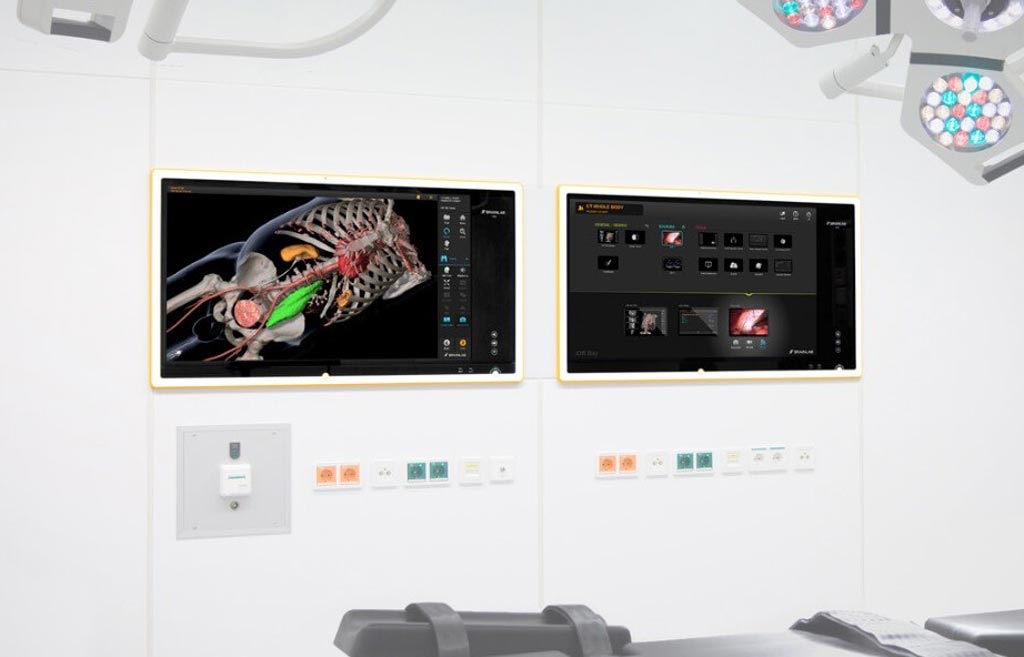Brainlab Presents Newest Advancements in Streamlining OR Workflow
|
By HospiMedica International staff writers Posted on 12 Nov 2018 |

Image: The Smart Anatomy Views are designed for fast and accurate surgical planning, hospital IT integration with automatic patient data pre-fetching in the OR, communication tools and easy intra- and post-op surgical documentation (Photo courtesy of Brainlab).
Brainlab (Munich, Bavaria) presented its newest advancements in streamlining the operating room (OR) workflow before, during and after surgery at MEDICA, the world’s biggest medical trade fair, held in Düsseldorf, Germany, from November 12-15, 2018.
The event offered a comprehensive overview of the latest medical products, services and developments for modern treatment in doctors’ practices and hospitals. At MEDICA 2018, the focus was on laboratory technology, physiotherapy and orthopedic technology, commodities and consumables, high-tech medicine (electrotherapy and medical technology) and healthcare IT, among others.
With its vast experience in hospital IT integration of video sources, hardware, software, and patient data management, Brainlab helps clients leverage their existing IT technology with simplified infrastructure, bringing unique value to the surgical and IT teams. Brainlab’s highlights at MEDICA 2018 included its automated indication-specific Smart Anatomy Views for fast and accurate surgical planning, sleek hospital IT integration with automatic patient data pre-fetching in the OR, communication tools, and easy intra- and post-op surgical documentation.
At MEDICA 2018, the company demonstrated how Brainlab Digital O.R. streamlines, simplifies and consolidates the huge influx of data to free up time not only for the surgeon, but the entire surgical team. Before the case, the right patient data and images are loaded from the PACS and HIS systems and are automatically displayed where the surgeon needs it most. During the procedure, digital time-out, high-end recordings and screenshots can be done and shared outside of the room with minimal effort. After the procedure, OR documentation is automatically transferred to the preferred picture archive or storage location (PACS, HIS, VNA, USB drive) and is accessible immediately on any client PC or connected iPad through the hospital HIS for review or patient consultation. DICOM surgical recordings can be saved in a temporary scalable storage server until they are edited on-the-fly with the Brainlab Video Editor, ensuring only the most relevant data is stored on the patient record in the HIS or downloadable in MP4 format.
Brainlab also demonstrated its new Smart Anatomy Views, which has been developed for various specialties (Cranial, Spine, Abdomen) and extracts the most relevant information from a variety of datasets (CT, MRI TOF, angiography), providing surgeons with unique anatomical insights in seconds and eliminating cumbersome steps in image preparation.
The event offered a comprehensive overview of the latest medical products, services and developments for modern treatment in doctors’ practices and hospitals. At MEDICA 2018, the focus was on laboratory technology, physiotherapy and orthopedic technology, commodities and consumables, high-tech medicine (electrotherapy and medical technology) and healthcare IT, among others.
With its vast experience in hospital IT integration of video sources, hardware, software, and patient data management, Brainlab helps clients leverage their existing IT technology with simplified infrastructure, bringing unique value to the surgical and IT teams. Brainlab’s highlights at MEDICA 2018 included its automated indication-specific Smart Anatomy Views for fast and accurate surgical planning, sleek hospital IT integration with automatic patient data pre-fetching in the OR, communication tools, and easy intra- and post-op surgical documentation.
At MEDICA 2018, the company demonstrated how Brainlab Digital O.R. streamlines, simplifies and consolidates the huge influx of data to free up time not only for the surgeon, but the entire surgical team. Before the case, the right patient data and images are loaded from the PACS and HIS systems and are automatically displayed where the surgeon needs it most. During the procedure, digital time-out, high-end recordings and screenshots can be done and shared outside of the room with minimal effort. After the procedure, OR documentation is automatically transferred to the preferred picture archive or storage location (PACS, HIS, VNA, USB drive) and is accessible immediately on any client PC or connected iPad through the hospital HIS for review or patient consultation. DICOM surgical recordings can be saved in a temporary scalable storage server until they are edited on-the-fly with the Brainlab Video Editor, ensuring only the most relevant data is stored on the patient record in the HIS or downloadable in MP4 format.
Brainlab also demonstrated its new Smart Anatomy Views, which has been developed for various specialties (Cranial, Spine, Abdomen) and extracts the most relevant information from a variety of datasets (CT, MRI TOF, angiography), providing surgeons with unique anatomical insights in seconds and eliminating cumbersome steps in image preparation.
Latest Medica 2018 News
- ParAid Medical Showcases Updated Ambulance Chair at MEDICA 2018
- Rober Showcases Pioneering ‘Zero Pressure’ Mattresses in Germany
- UK Companies Showcase Life-Saving Solutions at Medica 2018
- Siemens Healthineers Showcases ACUSON Ultrasound Product Portfolio
- Metaltronica Presents Digital Mammography Systems at Medical Trade Fair
- Canon Displays New Products at MEDICA Show
- Stratasys Shows How 3D Printing Improves Patient Outcome and Hospital Efficiency
- Merivaara Showcases Latest Innovations for Operating Room Solutions
- Derungs Licht Showcases Smart OR Lighting Solutions in Germany
- Barco Introduces Second Generation of 4K Surgical Displays at Trade Fair
- Aerotel Medical Systems Showcases Remote Monitoring and Professional ECG Recorders
Channels
Critical Care
view channel
AI Heart Attack Risk Assessment Tool Outperforms Existing Methods
For decades, doctors have relied on standardized scoring systems to assess patients with the most common type of heart attack—non-ST-elevation acute coronary syndrome (NSTE-ACS). The GRACE score, used... Read more
'Universal' Kidney to Match Any Blood Type
Blood-type incompatibility has long been one of the greatest obstacles in organ transplantation, forcing thousands of patients—particularly those with type O blood—to wait years longer for compatible donors.... Read moreSurgical Techniques
view channel
Minimally Invasive Endoscopic Surgery Improves Severe Stroke Outcomes
Intracerebral hemorrhage, a type of stroke caused by bleeding deep within the brain, remains one of the most challenging neurological emergencies to treat. Accounting for about 15% of all strokes, it carries... Read more
Novel Glue Prevents Complications After Breast Cancer Surgery
Seroma and prolonged lymphorrhea are among the most common complications following axillary lymphadenectomy in breast cancer patients. These postoperative issues can delay recovery and postpone the start... Read morePatient Care
view channel
Revolutionary Automatic IV-Line Flushing Device to Enhance Infusion Care
More than 80% of in-hospital patients receive intravenous (IV) therapy. Every dose of IV medicine delivered in a small volume (<250 mL) infusion bag should be followed by subsequent flushing to ensure... Read more
VR Training Tool Combats Contamination of Portable Medical Equipment
Healthcare-associated infections (HAIs) impact one in every 31 patients, cause nearly 100,000 deaths each year, and cost USD 28.4 billion in direct medical expenses. Notably, up to 75% of these infections... Read more
Portable Biosensor Platform to Reduce Hospital-Acquired Infections
Approximately 4 million patients in the European Union acquire healthcare-associated infections (HAIs) or nosocomial infections each year, with around 37,000 deaths directly resulting from these infections,... Read moreFirst-Of-Its-Kind Portable Germicidal Light Technology Disinfects High-Touch Clinical Surfaces in Seconds
Reducing healthcare-acquired infections (HAIs) remains a pressing issue within global healthcare systems. In the United States alone, 1.7 million patients contract HAIs annually, leading to approximately... Read moreHealth IT
view channel
Printable Molecule-Selective Nanoparticles Enable Mass Production of Wearable Biosensors
The future of medicine is likely to focus on the personalization of healthcare—understanding exactly what an individual requires and delivering the appropriate combination of nutrients, metabolites, and... Read moreBusiness
view channel
Philips and Masimo Partner to Advance Patient Monitoring Measurement Technologies
Royal Philips (Amsterdam, Netherlands) and Masimo (Irvine, California, USA) have renewed their multi-year strategic collaboration, combining Philips’ expertise in patient monitoring with Masimo’s noninvasive... Read more
B. Braun Acquires Digital Microsurgery Company True Digital Surgery
The high-end microsurgery market in neurosurgery, spine, and ENT is undergoing a significant transformation. Traditional analog microscopes are giving way to digital exoscopes, which provide improved visualization,... Read more
CMEF 2025 to Promote Holistic and High-Quality Development of Medical and Health Industry
The 92nd China International Medical Equipment Fair (CMEF 2025) Autumn Exhibition is scheduled to be held from September 26 to 29 at the China Import and Export Fair Complex (Canton Fair Complex) in Guangzhou.... Read more








.jpg)








